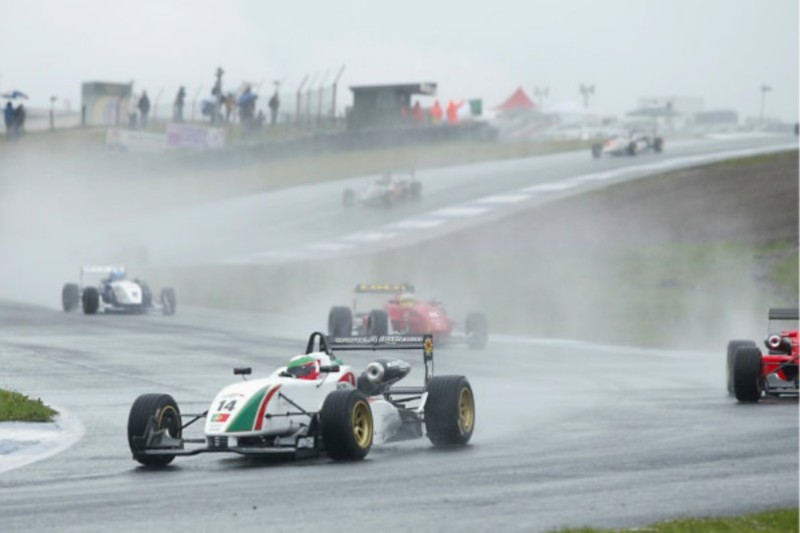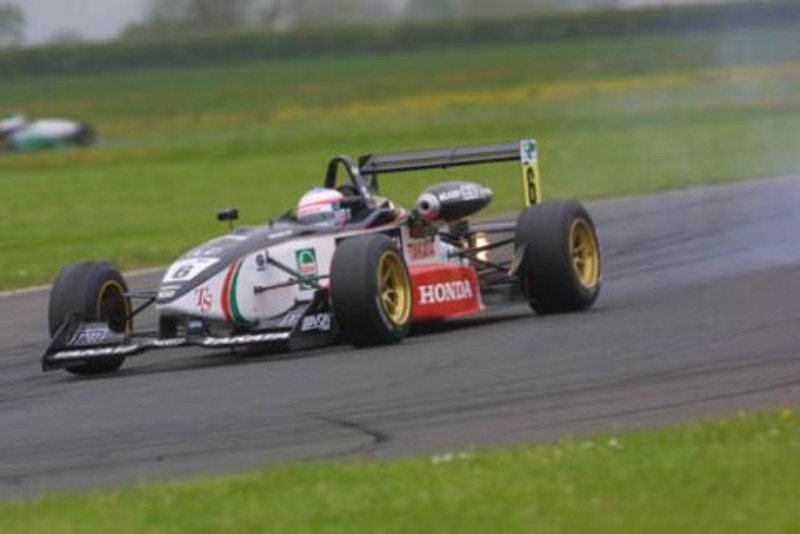
Photo: LAT Images / British F3 International Series
It’s been 15 years since the last Formula 3 race in Scotland, which marked the end of an era for the category and country in more ways than one. Formula Scout asks if F3 could return in the post-coronavirus world
On May 22 2005, Carlin’s Alvaro Parente took his third British Formula 3 win in a row at a rainy Knockhill. The Portuguese racer had beaten T-Sport’s Ryan Lewis to pole by 0.002 seconds earlier in the day, when the track had been really wet, and was the only driver who didn’t have to deal with spray in the race. As a result, he romped to victory by 8.186s.
Hitech Racing’s Marko Asmer, who now mentors Red Bull junior Juri Vips, passed Lewis on the opening lap and had him in his wing mirrors for the first third of the race. Lewis had the pace to be ahead, but wasn’t going to risk an overtake until he’d weighed up the grip levels around the circuit.
A mistake by Asmer at Clark corner on lap nine of 25 enabled Lewis to get through, but with his slimming title hopes on the line (such was Parente’s early-season form) he was quick to reclaim the position at the start of the next lap. That move ended up with Lewis going off track and then spinning on the slippy asphalt as he returned to the circuit.
Other off-track excursions brought more mud and water into play, which eventually caught out Asmer and allowed Fortec Motorsports’ Mike Conway past. The Estonian got another reprieve when Conway’s engine gave up with a few laps to go, and he ended up just holding off Parente’s team-mate Charlie Kimball on the final lap for second place.
After the race, the 11 British F3 teams packed up their trucks and drove back home to England. They didn’t know it at the time, but none of them would ever be making a return journey for the purposes of F3 racing.

Photo: Malcolm Griffiths
At the end of 2003, Stephane Ratel Organisation had become the promoter of British F3 in what was a disruptive year for the series. The merging of the French and German championships to create the F3 Euro Series had robbed Britain’s status of having the highest-profile series at that level, and changed the make-up of the Macau Grand Prix for the next 16 years.
Behind-the-scenes nuclear fallout, traceable to ill-thought wranglings over the British Grand Prix between circuits from before the century had even began, then led to the BRDC ending the organisational responsibilities it had accrued from series co-founder and fellow racing club BARC.
SRO’s task for 2004 was really to successfully promote a British F3 championship being held together (to varying degrees of agreement) by the series’ long-running teams’ association. Its European rival was already building up momentum, with its top drivers graduating straight into race seats in the DTM, Formula 1 and IndyCar.
It had not taken long for British F3 to be seen as a side programme for Euro Series drivers or as a learning ground before Europe, rather than an equal to it, and SRO responded to the teams’ association’s concerns by raising the number of overseas trips from one to four for 2005. At the same time, it dropped several UK tracks from the schedule when new circuit operating company MotorsportVision wanted to charge for use of its venues at a higher rate than British F3 had paid in previous years.
Those MSV tracks were some of the more lucrative in Britain to actually race at for overseas entries, and soon returned to the calendar. Three other British classics took the brunt for 2006, and Knockhill was never seen by the championship again.
From 2001 to ’05, the Scottish round was a staple of the schedule and was won by the likes of 2017 Indianapolis 500 winner Takuma Sato, 2014-15 Formula E champion Nelson Piquet Jr and 2010 Australian Supercars champion James Courtney.

It was the last time Scotland ever hosted F3, with the series now known as the F3 Cup (then ARP F3) having visited only once, in 1991. That race was won by William Hewland, son of gearbox pioneer Mike, who was taking over the reigns at his father’s company.
More importantly, Parente’s win marked the last time British F3 could actually claim to be true to the first bit of its name. In the years after that, the British F3 International Series and its BRDC-branded successor visited three circuits in France and Germany, two in Italy, and one apiece in Belgium, Ireland, Portugal and Romania. But not once did it head to Scotland or Wales, and the BRDC’s revival of its series has been an all-English series with one away trip to Spa-Francorchamps.
That’s a crying shame for fans in the other constituent countries of Great Britain, but historically the series has always been England-centric. From 1992 to 1999 there were races at Wales’ Pembrey circuit – with winners including former F1 driver Jan Magnussen, two-time IndyCar champion Gil de Ferran and 2009 F1 world champion Jenson Button – and Belgian talent Patrick Neve won the BARC British F3 race (pre-merger with the BRDC’s series) at the newly opened Knockhill in 1975.
From 1987 to 1989, Knockhill also held a non-championship race called the Scottish Superprix. Future Lotus F1 driver Martin Donnelly beat a 20-car grid to win the inaugural edition, while Gary Brabham was one of only eight entries in 1988 when he won for his father’s famous team. His brother David was the final victor in a slightly beefier 12-car field.
The only race specifically for F3 in Scotland the next decade was F3 Cup’s ’91 visit, while fans got to see a single F3 chassis competing in the open Formula Ecosse series in 1997, as they had in a Formula Libre race at the Ingliston circuit in 1970.
It’s back in the 1960s, when the 1000cc formula was created that became recognisable as F3 today, that the category did actually race across the British Isles.

Damon Hill leads the Scottish Superprix
Scotland’s Charterhall airfield circuit held club races in 1964, before Ingliston was created the next year and held a few club races every year from 1965-’69. For two years it also hosted a trophy race named after the sitting King of Jordan, which was won by Peter Gethin and Chris Williams.
Llando attracted a few FLibre races to Wales through to 1970 too, and Northern Ireland’s Kirkistown circuit held its own non-championship Ulster race in 1971, won by Colin Vandervell. Apart from that, F3 in the UK really was scarcely spread.
In the post-coronavirus world, holding overseas events is inevitably going to get harder, and the preference to hold events behind closed doors will remain at least for the short term. British championships may have to look at alternative cheaper venues to hold races, and BRDC British F3 may see the attraction in living up to its name and heading to Scotland and Wales.
More on classic F3
Five junior single-seater classics to revive for 2020
Why British F3 isn?t headed for a second (or third) oblivion
What if the Motorsport Games had taken place 50 years ago?
Why Euroformula Open?s Mediterranean GP adventure matters
The 1990s F1 embarrassment behind 2019?s surprise F3 star
Why Europe?s oldest street race is still going strong
The timeline of European F3?s (second) demise
Estonia: The underdog that keeps on achieving
